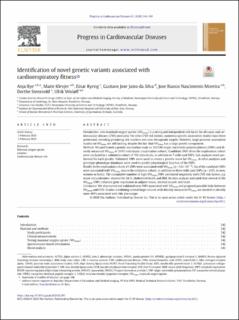| dc.contributor.author | Bye, Anja | |
| dc.contributor.author | Klevjer, Marie | |
| dc.contributor.author | Ryeng, Einar | |
| dc.contributor.author | Silva, Gustavo Jose Justo | |
| dc.contributor.author | Moreira, Jose Bianco Nascimento | |
| dc.contributor.author | Stensvold, Dorthe | |
| dc.contributor.author | Wisløff, Ulrik | |
| dc.date.accessioned | 2021-01-12T08:35:37Z | |
| dc.date.available | 2021-01-12T08:35:37Z | |
| dc.date.created | 2020-04-28T13:49:13Z | |
| dc.date.issued | 2020 | |
| dc.identifier.citation | Progress in cardiovascular diseases. 2020, 1-9. | en_US |
| dc.identifier.issn | 0033-0620 | |
| dc.identifier.uri | https://hdl.handle.net/11250/2722460 | |
| dc.description.abstract | Introduction
Low maximal oxygen uptake (VO2max) is a strong and independent risk factor for all-cause and cardiovascular disease (CVD) mortality. For other CVD risk factors, numerous genetic association studies have been performed, revealing promising risk markers and new therapeutic targets. However, large genomic association studies on VO2max are still lacking, despite the fact that VO2max has a large genetic component.
Methods
We performed a genetic association study on 123.545 single-nucleotide polymorphisms (SNPs) and directly measured VO2max in 3470 individuals (exploration cohort). Candidate SNPs from the exploration cohort were analyzed in a validation cohort of 718 individuals, in addition to 7 wild-card SNPs. Sub-analyses were performed for each gender. Validated SNPs were used to create a genetic score for VO2max. In silico analyses and genotype-phenotype databases were used to predict physiological function of the SNPs.
Results
In the exploration cohort, 41 SNPs were associated with VO2max (p < 5.0 ∗ 10−4). Six of the candidate SNPs were associated with VO2max also in the validation cohort, in addition to three wild-card SNPs (p < 0.05, in men, women or both). The cumulative number of high-VO2max-SNPs correlated negatively with CVD risk factors, e.g. waist-circumference, visceral fat, fat %, cholesterol levels and BMI. In silico analysis indicated that several of the VO2max-SNPs influence gene expression in adipose tissue, skeletal muscle and heart.
Conclusion
We discovered and validated new SNPs associated with VO2max and proposed possible links between VO2max and CVD. Studies combining several large cohorts with directly measured VO2max are needed to identify more SNPs associated with this phenotype. | en_US |
| dc.language.iso | eng | en_US |
| dc.publisher | Elsevier | en_US |
| dc.rights | Navngivelse 4.0 Internasjonal | * |
| dc.rights.uri | http://creativecommons.org/licenses/by/4.0/deed.no | * |
| dc.title | Identification of novel genetic variants associated with cardiorespiratory fitness | en_US |
| dc.type | Peer reviewed | en_US |
| dc.type | Journal article | en_US |
| dc.description.version | publishedVersion | en_US |
| dc.source.pagenumber | 1-9 | en_US |
| dc.source.journal | Progress in cardiovascular diseases | en_US |
| dc.identifier.doi | 10.1016/j.pcad.2020.02.001 | |
| dc.identifier.cristin | 1808462 | |
| dc.description.localcode | © 2020 The Authors. Published by Elsevier Inc. This is an open access article under the CC BY license (http://creativecommons.org/licenses/by/4.0/). | en_US |
| cristin.ispublished | true | |
| cristin.fulltext | original | |
| cristin.qualitycode | 1 | |

